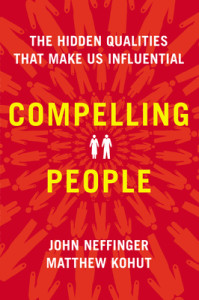Compelling People: the Hidden Qualities that Make Us Influential
 Personal influence can be a slippery or vague concept to wrap your head around. Is it something you are either born with or without, or can it be dissected, analyzed and learned?
Personal influence can be a slippery or vague concept to wrap your head around. Is it something you are either born with or without, or can it be dissected, analyzed and learned?
Compelling People: The Hidden Qualities That Make Us Influential by John Neffinger and Matthew Kohut, comes down firmly on the second half of that critical question. The key ideas of the book are that:
a) personal influence is primarily a product of the reaction you engender in others, and
b) their perception is a product of the two dimensions of strength and warmth, and
c) using these two dimensions as a lens, you can make adjustments to your own approach to make yourself more influential.
Personal influence is primarily a product of the reaction you engender in others
As we’ve seen before, Aristotle said that ethos is the most important component of persuasion. Quite simply, people are willing to listen, learn and act depending on how they feel about the source. If they respect or fear the source, they will go along as long as the power remains. If they like the source, they might be more willing to be persuaded as long as it doesn’t go against their own interests.[1] Respect and liking together make for admiration and it can accomplish great things. So, how do you get there?
Understand the critical components of strength and warmth
Strength is the perception of your ability plus the will to get things done, and it’s critical to influence, because people won’t follow your lead on important matters if they see you as ignorant or weak. Yet strength by itself can only coerce or intimidate.
Warmth is empathy and concern for others. Warmth can get people to like you and want to do things for you, but warmth by itself can also get people to walk all over you.
The ideal leader or influencer is seen as both strong and warm. As that great influencer Al Capone said, “You can get further with a kind word and a gun than with a kind word alone.”
The problem is that strength and warmth are fundamentally in tension with each other. Dial up strength, and you risk being seen as cold or uncaring. Dial up warmth, and you might be seen as vulnerable.
Viewing persuasive influence through the dimensions of strength and warmth is like putting on polarized lenses, letting you see under the surface to the process below. In the week or so since I read the book, I’ve started seeing the relative amounts of either dimension in interpersonal contacts, both my own and others’. For another example, the controversy about relationship selling vs. challenger selling is fundamentally about the relative importance of each dimension.
That clearer view is what allows you to be smart about any adjustments that you need to make.
Dial up strength and warmth as needed
The bulk of the book is a practical “how-to”; once you have analyzed how you come across, you can figure out how to dial up each dimension. Although a lot of the recommendations are things you’ve probably seen before, they are explained comprehensively, clearly, and usefully. The main section of the book treats the nuts and bolts of influence, including nonverbal and verbal communication. The last section addresses how to use the ideas in the real world, such as in the workplace, in public speaking, even on-line.
You’ll have to read the book to get the individual recipes, but there are two critical messages in the how-to section. The first is that, although strength and warmth are largely determined by the hand you are dealt through genetics and upbringing, there is still a lot that you can change and control if you decide to. You can change behaviors and habits through knowledge and hard work, using the techniques described.
The second important theme is that there are two routes to those changes. One is outside-in, just doing things differently. For example, standing up straighter and taking up more space will not only make you look stronger, it can actually make you feel more powerful. It’s called embodied cognition, although most of us know it as “fake it ‘til you make it.” The inside-out route is more effective in the long term; if you change the way you feel inside, you will change your outward behaviors, e.g. the best way to show people you like them is to actually like them better. This sounds superficially obvious and difficult at the same time, but there are techniques described in the book that can help change your frame of mind.
If you’re still stuck on a gift idea for the influencer on your list (even if it’s yourself) I strongly and warmly recommend Compelling People.
[1] Machiavelli addressed this tension by asking whether it’s better for the prince to feared or loved. He concluded that it’s better to be feared, because people are quick to set aside their affection if they see the opportunity for gain or if they fear someone else more. But even Machiavelli acknowledged the importance of warmth by cautioning that even though a prince does not have to be loved, he should also not be hated.





[…] and guns are the velvet glove and iron fist of persuasive communication. Psychologists call them warmth and strength, but the idea is the […]